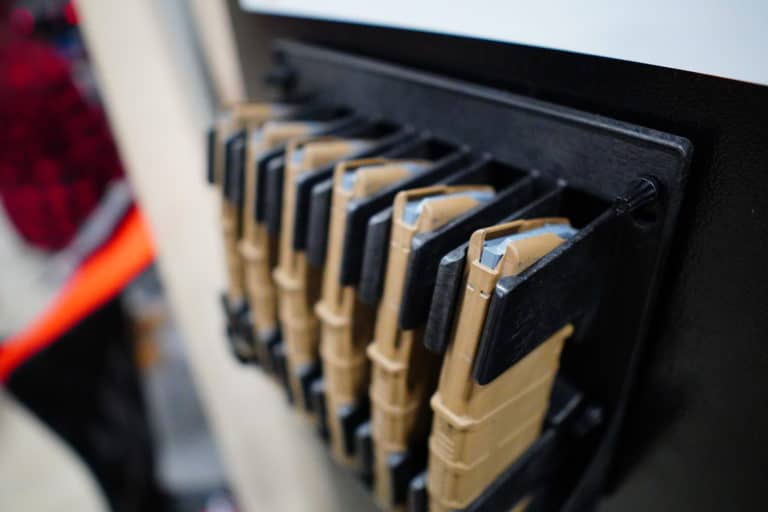The answer is yes, at least according to one federal appeals court.
On Tuesday, a panel on the DC Circuit Court of Appeals upheld the capital city’s ban on magazines that hold more than ten rounds of ammunition. It did so despite finding the magazines were “arms” and they were in “common use” for self-defense, which puts them squarely inside the scope of the Second Amendment’s protections. It even rejected most of the historical analogues offered up by DC to justify its ban.
So, how did the panel still reach the same conclusion as other federal judges who haven’t gone half that far? And what are the implications and weaknesses of its ruling?
In Hanson v. DC, the split panel started with an examination of whether the banned “extra-large capacity magazines” (ELCM) are part of the “arms” the Constitution allows the people to keep and bear. It answered that question easily, arguing detachable magazines are necessary for the functioning of the semi-automatic handguns the Supreme Court has already determined are protected.
“‘Constitutional rights . . . implicitly protect those closely related acts necessary to their exercise.’ A magazine is necessary to make meaningful an individual’s right to carry a handgun for self-defense,” the majority wrote in an unsigned opinion. “To hold otherwise would allow the government to sidestep the Second Amendment with a regulation prohibiting possession at the component level, ‘such as a firing pin.’ We therefore agree with Hanson and the district court that ELCMs very likely are ‘Arms’ within the meaning of the plain text of the Second Amendment.”
Then, it moved to whether they are in “common use for self-defense.” While there is significant dispute over whether the “common use” standard created in 1934’s US v. Miller and emphasized in 2008’s DC v. Heller applies to arms used specifically for self-defense or merely any lawful purpose, the panel ultimately assumed ELCMs are specifically used for self-defense.
“The District argues ELCMs are not in common use for self-defense because they are rarely used to fire more than a couple rounds in self-defense. Hanson replies that one need not fire every bullet in an ELCM in order to use it,” the majority wrote. “Because ELCMs are in sufficiently wide circulation and given the disputed facts in the record about the role of ELCMs for self-defense, we will presume for present purposes that ELCMs can be used for self-defense. Accordingly, because Hanson has shown it is likely that ELCMs are ‘arms’ and are in common use for self-defense today, it appears on this record that ‘the Second Amendment’s plain text covers’ and therefore presumptively protects the possession of ELCMs.”
Ultimately, it agreed there were no historical magazine bans or general ammunition limits, but that’s the point where the majority pivoted to a familiar frame. It argued ELCMs are “weapons particularly capable of unprecedented lethality,” which were only developed well after the Founding Era and led to a new problem.
“Large capacity magazines have given rise to an unprecedented societal concern: mass shootings,” it wrote. “As the First Circuit has observed, there is ‘no direct precedent for the contemporary and growing societal concern that [ELCMs] have become the preferred tool for murderous individuals intent on killing as many people as possible, as quickly as possible.’ This comes as no surprise, because
mass shootings themselves are a relatively recent phenomenon: ‘The first known mass shooting resulting in ten or more deaths did not occur in this country until 1949.'”
That meant it could look for historical analogues to DC’s modern magazine ban under a looser standard. Still, the majority found the idea 18th Century gunpowder storage laws were “relevantly similar” to the capacity limit “silly.” It said prohibitions on trap guns, concealed carry, or shooting inside city limits were also poor comparisons.
Instead, it found various bans on the carry or possession of Bowie knives and pocket pistols from the late 19th Century were fitting analogues for the modern magazine ban. It said those bans, coupled with later regulations on machinegun magazines and sawed-off shotguns, created a historical tradition.
“The broader regulation of weapons that are particularly capable of unprecedented lethality includes other prominent examples, such as the ban on sawed-off shotguns held constitutional by the Supreme Court in Miller and implicitly approved in Heller,” the majority wrote. “The examples above regarding Prohibition-era bans on machine guns, although insufficient to support a tradition of regulating magazines in and of themselves, fit nicely into the tradition of regulating weapons particularly capable of unprecedented lethality[.]”
In the end, the majority decided that was enough for the magazine ban to stand.
“Finally, the District and its amici argue that historical restrictions on particularly dangerous weapons and on the related category of weapons particularly capable of unprecedented lethality constitute a relevantly similar tradition,” the majority wrote. “Those laws are commensurate with the District’s justification of its magazine cap to counter ‘the growing use of [ELCMs] to facilitate crime and, specifically, to perpetrate mass shootings.’ Therefore, on the limited record before us, we agree with the District that it has identified a relevant historical analogue and Hanson is not likely to succeed on the merits of his claim.”
Oddly, this same logic would seem to apply to the semi-automatic guns the magazines are used in. The same kind the Supreme Court explicitly identified as protected by the Second Amendment. The majority doesn’t address that issue.
Judge Justin Walker’s dissent made a similar point.
“[I]f plus-ten magazines are (1) half of America’s magazines, (2) owned by half of America’s gun owners, and (3) often standard on Americans’ preferred weapon for self-defense, what else needs to be said? That is (more than) enough to show common use for lawful purposes,” Walker, a Trump appointee, wrote. “In the context of a complete ban on a category of arms, ‘that is all that is needed for citizens to have a right under the Second Amendment to keep such weapons.’ Heller held that because handguns are ‘in common use,’ D.C.’s ‘complete prohibition of their use is invalid.’ For the same reason, D.C.’s ban on plus-ten magazines is unconstitutional.”
He also hit on the problem that’s more likely to undo the panel’s decision if it ever makes its way up to the High Court. He argued that the Supreme Court had already done a historical analysis of whether an arm in common use could be banned in Heller and determined that the answer was no.
“There is an individual (though not unlimited) right to possess and carry arms. Exceptions to that right depend on history and tradition,” he wrote of the High Court’s conclusion. “There is no history and tradition of banning arms in common use for lawful purposes. D.C. cannot categorically ban handguns because they are in common use.”
He argued the Court’s later decisions expanded on this, but not in a way that helped DC’s magazine ban.
“To Heller’s final and most specific holding, we can add the most specific holdings of McDonald, Bruen, and Rahimi,” he wrote. “Like the federal government and federal enclaves, states too cannot categorically ban handguns because they are in common use for lawful purposes — McDonald. The government also cannot impose an unusually restrictive licensing regime like New York’s because it is inconsistent with the nation’s historical tradition — Bruen. In contrast, the government can temporarily disarm people who present a credible threat of violence because that type of law is consistent with the nation’s historical tradition — Rahimi.”
Judge Walker then goes on to dispute the majority’s historical analysis as well. He argued the laws cited in the panel’s decision are either outside the relevant time period for assessing the Founders’ intent, like the machinegun magazine regulations, or aren’t similar to the modern regulation at all, like the Bowie knife bans. Ultimately, though, he came back to the same point that it shouldn’t really matter because the case should have been decided the moment the panel found the banned magazines are arms in common use.
“In the context of a complete ban on a category of arms, ‘that is all that is needed for citizens to have a right under the Second Amendment to keep such weapons,'” he wrote. “Heller held that because handguns are ‘in common use,’ D.C.’s ‘complete prohibition of their use is invalid.’ For the same reason, D.C.’s ban on plus-ten magazines is unconstitutional.”
The Supreme Court may well side with Walker’s reading of their work. But, for DC residents hoping to carry magazines that hold more than ten rounds, the case probably won’t make it to them for a while longer. At least so long as the High Court continues to sidestep Second Amendment cases the way it’s been doing the past few months.






